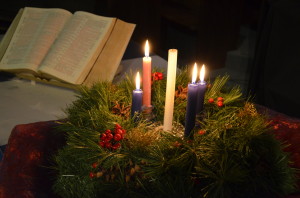A Time Called… Advent

When children say, “I can’t wait for Christmas,” they convey what it means to live in Advent. With joy they are waiting for an event that is good, that has been promised, and is now hidden from sight. Children do manage to wait. One way they do this is by sharing in the many preparations for Christmas. Waiting and preparing are the themes of Advent for adults as well. But when did Advent begin? And what can it mean in your life?
Historical Roots of Advent
The calendar year may begin on January 1, but for Christians the Christian year begins with Advent – four weeks before Christmas. Advent is the beginning of a cycle of time that celebrates the birth, life, death, and resurrection of Christ. It may originally have been a time of instruction for people who were preparing to be baptized on January 6, on Epiphany. History reveals Advent traditions of varying lengths, but our waiting time is now the four Sundays before Christmas.
Finding Meaning in the Tradition
Advent is the time when Christians prepare to celebrate the birth of Jesus. We recall those who waited and prepared for a promised Christ child: the prophet Isaiah, Mary, his mother, and John the Baptist. We also think about God’s promises that are yet to be revealed under the reign of Christ, in “the age to come” or “the day of the Lord.” Advent is oriented in both the past and the future. As we get ready for the birth of Jesus and for the promise that Christ will come again, we use gifts of spiritual preparation: worship, prayer, singing, Bible study, fellowship (Christmas parties!), and service to others.
The Advent wreath, is a Christian tradition that symbolizes the passage of the four weeks of Advent.
The Advent wreath is often an evergreen wreath with four candles, sometimes with a fifth, white candle in the center. Beginning with the First Sunday of Advent, the lighting of a candle can be accompanied by a Bible reading and prayers. An additional candle is lit each Sunday until, by the last Sunday of Advent, all four candles are lit. Our Advent wreath includes a fifth, Christ candle, which is lit on Christmas Eve.
Advent wreaths are usually circular, representing God’s infinite love, and are made of evergreen leaves, which represent the hope of eternal life brought by Jesus. Within the Advent wreath are candles that generally represent the four weeks of the Advent season as well as “the light of God coming into the world through the birth of Jesus Christ.” The candles can also symbolize the Christian concepts of hope (week one), peace (week two), joy (week three) and love (week four).
The most popular colours for the four Advent candles are violet (or blue) and rose. In the past, we have used violet candles to represent a season of penitetence. Recently, the United Church has moved to the colour blue, as it represents hopefulness, reflective of the theme of Advent. Rose (pink) is the liturgical color for the Third Sunday of Advent, known as Gaudete Sunday (from the Latin word meaning “rejoice ye”). The third candle, representing joy, is often a different color from the other three.
The flames of the candles are the representation of the Christmas light approaching and bringing hope and peace, as well as the symbol of the struggle against darkness.


You must be logged in to post a comment.